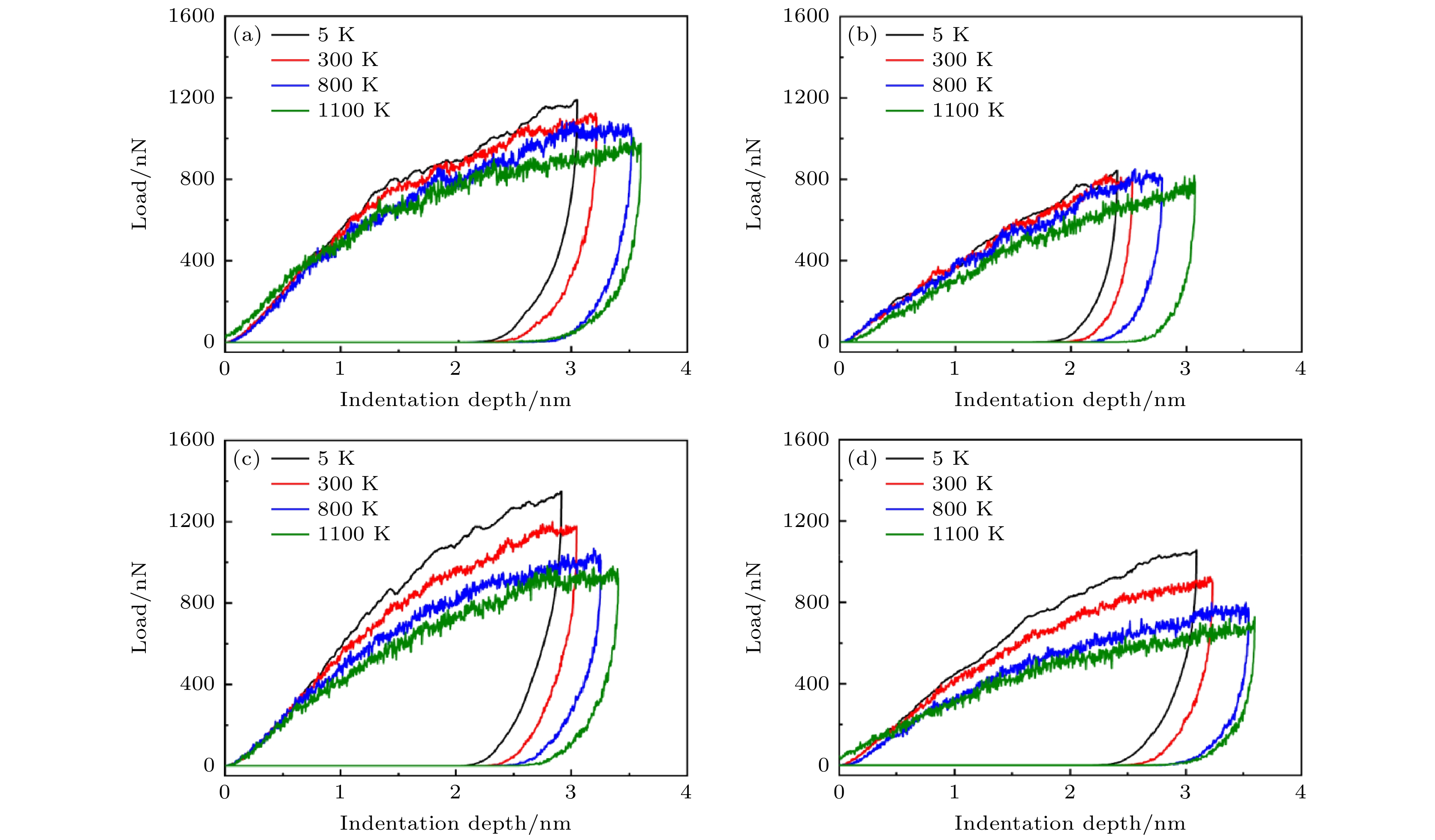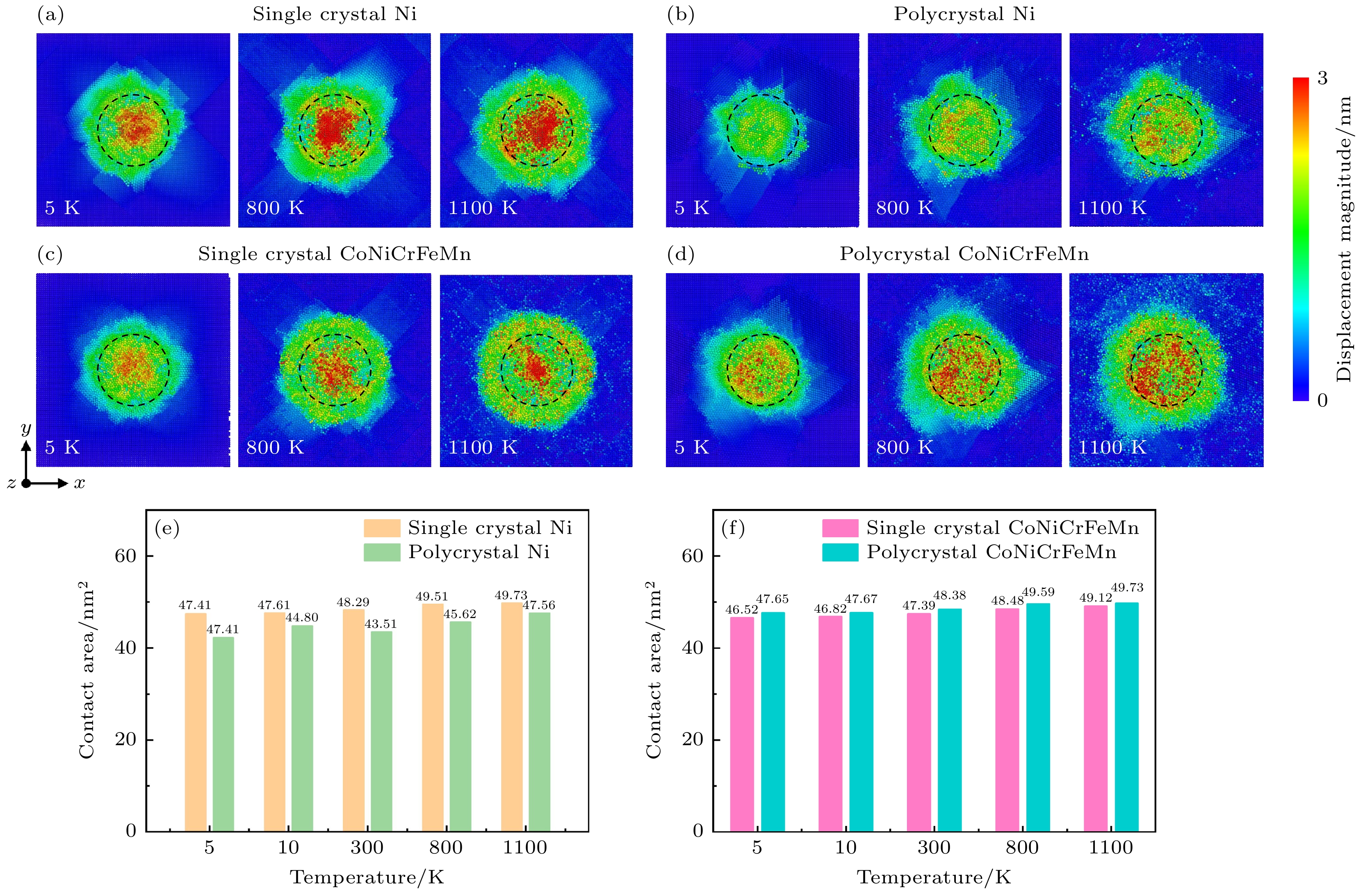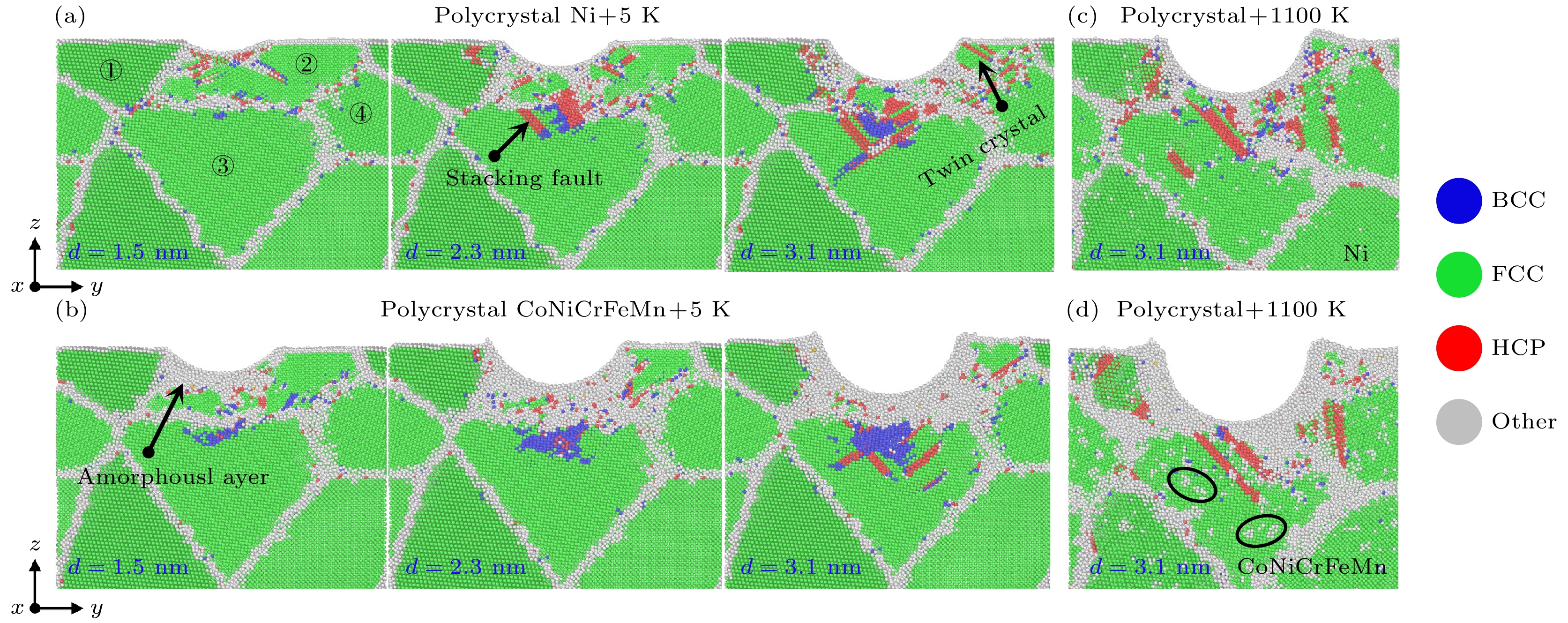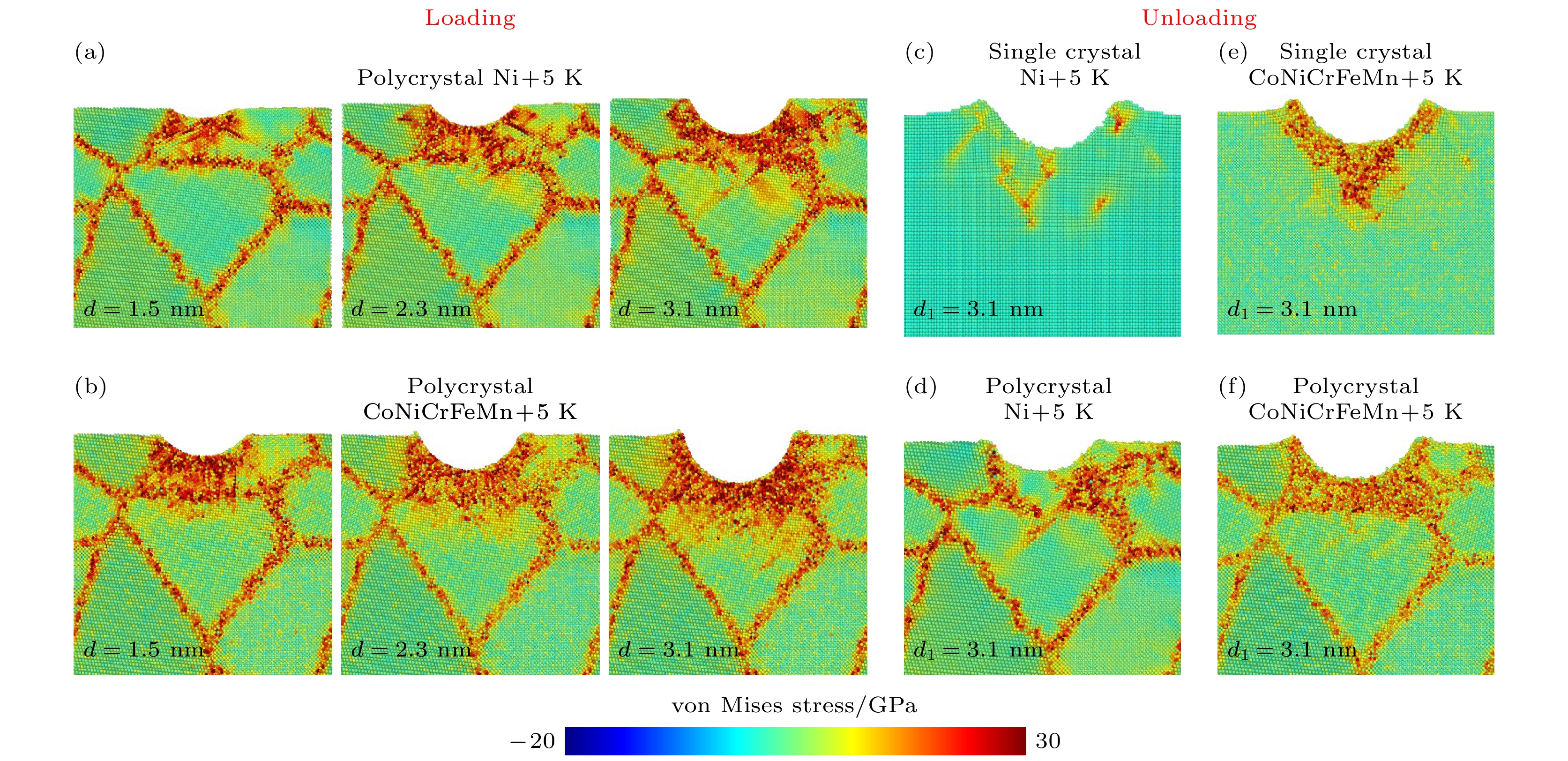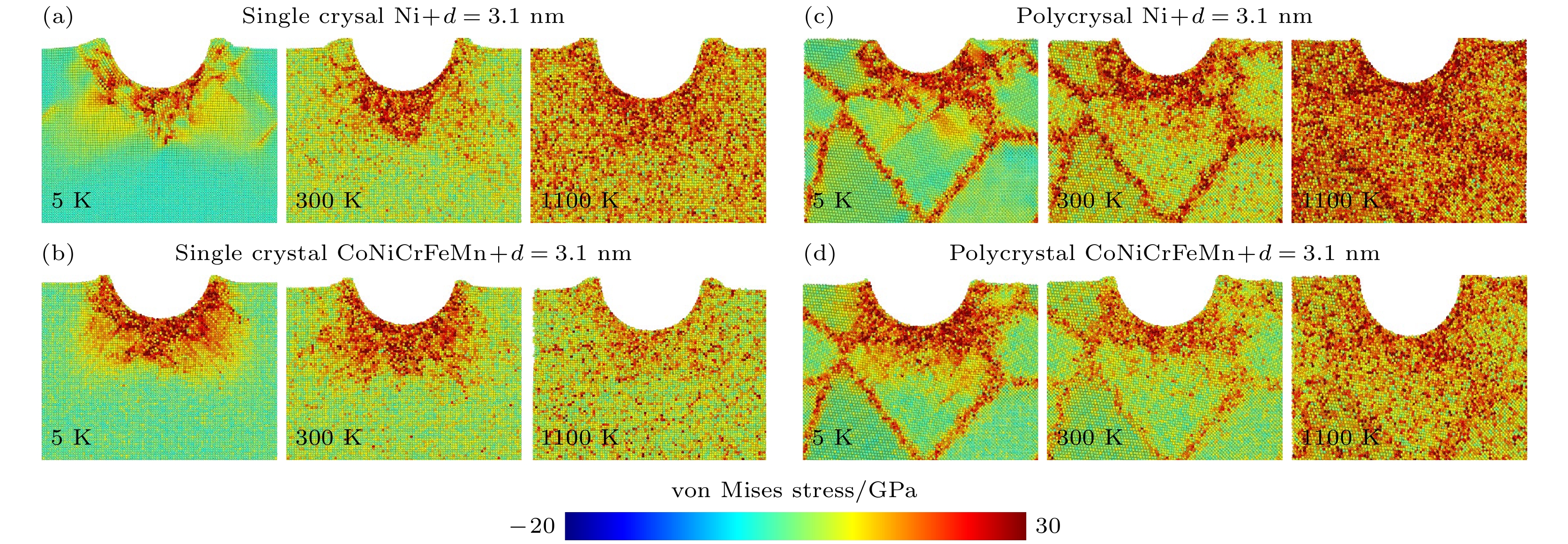-
对纳米晶(单晶、多晶)CoNiCrFeMn高熵合金的力学性能评估有助于理解高熵合金材料物性, 更好地服务于核反应堆包壳管、航空发动机、喷气涡轮叶片等国防应用领域发展. 本文提出对纳米晶CoNiCrFeMn高熵合金微结构演化与力学性能间的相关性展开研究. 基于纳米压痕法, 研究了纳米晶高熵合金和纳米晶镍的变形行为与力学性能, 比较了使役温度对纳米晶CoNiCrFeMn高熵合金和纳米晶Ni的力学性能与微结构演化差异. 结果表明: 单晶高熵合金力学性能(最大承载荷、硬度、杨氏模量、接触刚度)优越于单晶镍主要源于单晶高熵合金外形呈鼓包式结构内的位错滑移与拓展传播受到局限域的阻滞作用. 极端低温5 K下的材料力学性能表现最佳, 多晶Ni相比单晶Ni的最大承载荷、硬度、杨氏模量、接触刚度降幅分别达28.9%, 20.27%, 32.61%, 36.4%; 多晶CoNiCrFeMn高熵合金相比单晶CoNiCrFeMn高熵合金的最大承载荷、硬度、杨氏模量、接触刚度降幅依次达21.74%, 23.61%, 23.79%, 22.90%. 此外, 多晶高熵合金力学性能相比单晶高熵合金对温度敏感性更强, 其力学性能随温度升高近似线性下降. 对多晶高熵合金和多晶镍而言, 晶界不仅是位错滋生、拓展、繁衍的起源区, 更是萌生缺陷、产生裂纹拓展与失效的集中域. 受应力驱动晶界边缘的微结构演化和缺陷存在, 多晶材料力学性能弱于单晶材料.
-
关键词:
- CoNiCrFeMn高熵合金 /
- 纳米压痕 /
- 温度响应 /
- 力学性能 /
- 分子模拟
Physical property and material mechanical performance of nanocrystalline (single crystal, polycrystalline) CoNiCrFeMn alloy can be known well through an in-depth understanding of the micro-evaluation behaviour of micro dislocation, so that it can better be used in defense fields, such as nuclear reactor cladding tubes, aircraft engines, jet turbine blades and others. In this paper we propose to study the correlation between micro-structure evolution and mechanical properties for nanocrystalline CoNiCrFeMn high entropy alloy. The force driven material deformation behaviors and mechanical properties of nanocrystalline alloy and Ni material are studied by using the nanoindentation method, and effects of temperature on the mechanical properties and micro-structure evolution are compared as well. Research results show that the mechanical properties (maximum load, hardness, Young’s modulus and contact stiffness) of single crystal alloy are superior to those of single crystal Ni, which mainly stems from the fact that the single crystal high entropy alloy with a drum-shape structure is produced under loading period, and the slip and expansion of dislocations in the bulge structure are blocked. At a low temperature (5 K), the maximum load, hardness, Young's modulus and contact stiffness of polycrystalline Ni decrease by 28.9%, 20.27%, 32.61% and 36.4% respectively in comparison with those of single crystal Ni. The maximum load, hardness, Young's modulus and contact stiffness of polycrystalline CoNiCrFeMn material decrease by 21.74%, 23.61%, 23.79% and 22.90% respectively with respect to those of single CoNiCrFeMn high entropy alloy. In addition, the mechanical properties of polycrystalline alloy are more sensitive to temperature than those of single crystal high entropy alloy, whose mechanical properties decrease approximately linearly with temperature increasing. For polycrystalline CoNiCrFeMn and Ni material, the grain boundary is not merely the origin region of dislocation breeding, expansion and reproduction, but also the concentration region of defect initiation, crack expansion and failure. Its mechanical properties are weaker than those of single crystal materials due to micro-structure evolution of grain boundaries driven from stress concentration and defects existence.-
Keywords:
- CoNiCrFeMn high entropy alloy /
- nano indentation /
- temperature response /
- mechanical performance /
- molecular simulation
[1] Fu W J, Huang Y J, Sun J F, Ngan A H W 2022 Int. J. Plast 154 103296
 Google Scholar
Google Scholar
[2] Tran N D, Saengdeejing A, Suzuki K, Miura H, Chen Y 2021 J. Phase Equilib. Diffus 42 606
 Google Scholar
Google Scholar
[3] Gorban V F, Andreev A A, Chikryzhov A M, Karpets M. V, Krapivka N A, Kovteba D V 2019 Powder Metall 58 58
 Google Scholar
Google Scholar
[4] Zheng T F, Lü J C, Wu Y 2021 Appl. Phys. Lett 119 201907
 Google Scholar
Google Scholar
[5] Tripathi P K, Chiu Y C, Bhowmick S 2021 J. Nanomater 11 2111
 Google Scholar
Google Scholar
[6] Li C, Xue Y, Hua M, Cao T Q, Ma L L, Wang L 2016 Mater. Des 90 601
 Google Scholar
Google Scholar
[7] Wang F J, Zhang Y, Chen G L 2009 J. Alloys Compd 478 321
 Google Scholar
Google Scholar
[8] Sun S J, Tian Y Z, Lin H R, Yang H J, Dong X G, Wang Y H, Zhang Z F 2018 Mater. Sci. Eng. , A 712 603
 Google Scholar
Google Scholar
[9] Juan C C, Tsai M H, Tsai C W, Hsu W L, Lin C M, Chen S K, Lin S J, Yeh J W 2016 Mater. Lett 184 200
 Google Scholar
Google Scholar
[10] Seol J B, Bae J W, Li Z, Han J C, Kim J G, Raabe D, Kim H S 2018 Acta Mater 151 366
 Google Scholar
Google Scholar
[11] Gou S Y, Li S C, Hu H L, Fang Y T, Liu J B, Dong W P, Wang H T 2021 Mater. Res. Lett 9 437
 Google Scholar
Google Scholar
[12] Li X Y, Sun S J, Zou Y 2022 Mater. Res. Lett 10 385
 Google Scholar
Google Scholar
[13] Zhao W R, Han J K, Kuzminova Y O 2021 Mater. Sci. Eng. , A 807 140898
 Google Scholar
Google Scholar
[14] Laplanche G, Kostka K, Horst O M, Eggeler G, George E P 2016 Acta Mater 118 152
 Google Scholar
Google Scholar
[15] Schuh B, Mendez-Martin F, Völker B, George E P, Clemens H, Pippan R 2015 Acta Mater 96 258
 Google Scholar
Google Scholar
[16] He J Y, Zhu C, Zhou D Q 2014 Intermetallics 55 9
 Google Scholar
Google Scholar
[17] Otto F, Dlouhy A, Somsen C, Bei H, Eggeler G, George E P 2013 Acta Mater 61 5743
 Google Scholar
Google Scholar
[18] Yu Y, Wang J, Li J S, Yang J, Kou H C, Liu W M 2016 J. Mater. Sci. Technol 32 470
 Google Scholar
Google Scholar
[19] Plimpton S 1995 J. Comput. Phys 117 1
 Google Scholar
Google Scholar
[20] Guo J, Chen J J, Wang Y Q 2020 Ceram. Int 46 12686
 Google Scholar
Google Scholar
[21] Xiang H G, Li H T, Fu T 2017 Acta Materialia 138 131
 Google Scholar
Google Scholar
[22] Xiang H G, Li H T, Fu T, Huang C, Peng X H 2017 Acta Mater. 138 131
[23] Lee B J, Shim J H, Baskes M I 2003 Phys. Rev. B 68 144112
 Google Scholar
Google Scholar
[24] 董斌, 王雪梅, 朱子亮 2020 原子与分子物理学报 37 591
Dong B, Wang X M, Zhu Z L 2020 J. At. Mol. Phys. 37 591
[25] Fang Q H, Chen Y, Li J 2019 Int. J. Plast 114 161
 Google Scholar
Google Scholar
[26] Foiles, S M, Baskes, M I, Daw M S 1988 Phys. Rev. B 33 7983
[27] Qian Y, Shang F, Wan Q 2018 J. Phys. D 24 115102
[28] Qian Y, Shang F, Wan Q 2018 Comput. Mater. Sci 149 230
 Google Scholar
Google Scholar
[29] Goel S, Luo X, Reuben R L 2012 Appl. Phys. Lett 100 231
[30] Shimizu F, Ogata S, Li J 2007 Mater. Trans 48 2923
 Google Scholar
Google Scholar
[31] Oliver W C, Pharr G M 1992 J. Mater. Sci 7 1564
[32] Fan X, Rui Z, Cao H, Fu R, Feng R 2019 Materials 12 770
 Google Scholar
Google Scholar
[33] Belak J, Boercker D B, Stowers I F 1993 MRS Bull 18 55
-
图 1 纳米晶Ni和纳米晶CoNiCrFeMn高熵合金的四种待测样品物理模型 (a) 单晶Ni模型; (b) 单晶CoNiCrFeMn高熵合金模型; (c) 多晶Ni模型; (d) 多晶CoNiCrFeMn高熵合金模型; (e) CoNiCrFeMn高熵合金五种元素均匀分布
Fig. 1. Atomic nanoindentation simulation of physical model for single crystal high entropy alloy CoNiCrFeMn and single crystal Ni: (a) Single crystal Ni; (b) single crystal CoNiCrFeMn high entropy alloy; (c) polycrystal Ni; (d) polycrystal CoNiCrFeMn high entropy alloy; (e) uniform distributions of five elements in CoNiCrFeMn high entropy alloy.
图 3 极端低温5 K的纳米晶CoNiCrFeMn高熵合金和纳米晶Ni上表面受载诱导的剪切变形 (a), (b) 加载过程; (c) 卸载过程
Fig. 3. Atomic snapshoot of shear strain deformation induced by maximum loads at nanoindentation test ((a), (b) loading and (c) unloading process) during extremely low temperature 5 K for single crystal and polycrystal material (Ni and CoNiCrFeMn ) that can be seen from XY horizontal plane perspective view.
图 5 最大压深载荷时的纳米晶Ni(a), (b)、纳米晶CoNiCrFeMn高熵合金(c), (d)受极端高低温(5—1100 K)影响的表面形貌特征; 相应地接触面积 (e)纳米晶Ni; (f)纳米晶CoNiCrFeMn高熵合金
Fig. 5. Surface topography snapshot of nanocrystalline nickel and nanocrystalline high entropy alloys at maximum loading moment for testing four specimen with ambient temperature (5 K~1100 K)variations as shown in Fig. 5(a)-(d), among then, the locked position of virtual indenter was indicated with black dotted line. In addition, whose corresponding contact area was statisticed and quantified at Fig. 5(e) and 5(f).
图 8 纳米晶Ni和纳米晶CoNiCrFeMn高熵合金材料内部的位错类型分布与量化统计 (a) 单晶Ni和CoNiCrFeMn; (b) 多晶Ni和CoNiCrFeMn
Fig. 8. Distribution characteristics and data statistics of dislocation types in nanocrystalline Ni and nanocrystalline CoNiCrFeMn high entropy alloys: (a) Single crystal Ni and CoNiCrFeMn; (b) polycrystal Ni and CoNiCrFeMn.
图 9 极端低温5 K下的纳米晶Ni和CoNiCrFeMn高熵合金的应力分布状态 (a) 加载下多晶Ni; (b) 加载下多晶CoNiCrFeMn; (c) 卸载后单晶Ni和CoNiCrFeMn; (d) 卸载后多晶Ni和CoNiCrFeMn
Fig. 9. Atomic stress distribution of nanocrystalline Ni and nanocrystalline CoNiCrFeMn high entropy alloys under extremely low temperature with 5 K: (a) Polycrystal Ni under loading; (b) polycrystal CoNiCrFeMn under loading; (c) single crystal Ni and CoNiCrFeMn under unloading; (d) polycrystal Ni and CoNiCrFeMn under unloading.
图 10 加载期的纳米晶Ni和纳米晶CoNiCrFeMn高熵合金的应力分布受温度响应的影响 (a) 单晶Ni; (b) 多晶Ni; (c) 单晶CoNiCrFeMn; (d) 多晶CoNiCrFeMn
Fig. 10. Atomic stress distribution of nanocrystalline Ni and nanocrystalline CoNiCrFeMn high entropy alloys effected by temperature variations at loading process: (a) Single crystal Ni; (b) polycrystal Ni; (c) single crystal CoNiCrFeMn; (d) polycrystal CoNiCrFeMn.
-
[1] Fu W J, Huang Y J, Sun J F, Ngan A H W 2022 Int. J. Plast 154 103296
 Google Scholar
Google Scholar
[2] Tran N D, Saengdeejing A, Suzuki K, Miura H, Chen Y 2021 J. Phase Equilib. Diffus 42 606
 Google Scholar
Google Scholar
[3] Gorban V F, Andreev A A, Chikryzhov A M, Karpets M. V, Krapivka N A, Kovteba D V 2019 Powder Metall 58 58
 Google Scholar
Google Scholar
[4] Zheng T F, Lü J C, Wu Y 2021 Appl. Phys. Lett 119 201907
 Google Scholar
Google Scholar
[5] Tripathi P K, Chiu Y C, Bhowmick S 2021 J. Nanomater 11 2111
 Google Scholar
Google Scholar
[6] Li C, Xue Y, Hua M, Cao T Q, Ma L L, Wang L 2016 Mater. Des 90 601
 Google Scholar
Google Scholar
[7] Wang F J, Zhang Y, Chen G L 2009 J. Alloys Compd 478 321
 Google Scholar
Google Scholar
[8] Sun S J, Tian Y Z, Lin H R, Yang H J, Dong X G, Wang Y H, Zhang Z F 2018 Mater. Sci. Eng. , A 712 603
 Google Scholar
Google Scholar
[9] Juan C C, Tsai M H, Tsai C W, Hsu W L, Lin C M, Chen S K, Lin S J, Yeh J W 2016 Mater. Lett 184 200
 Google Scholar
Google Scholar
[10] Seol J B, Bae J W, Li Z, Han J C, Kim J G, Raabe D, Kim H S 2018 Acta Mater 151 366
 Google Scholar
Google Scholar
[11] Gou S Y, Li S C, Hu H L, Fang Y T, Liu J B, Dong W P, Wang H T 2021 Mater. Res. Lett 9 437
 Google Scholar
Google Scholar
[12] Li X Y, Sun S J, Zou Y 2022 Mater. Res. Lett 10 385
 Google Scholar
Google Scholar
[13] Zhao W R, Han J K, Kuzminova Y O 2021 Mater. Sci. Eng. , A 807 140898
 Google Scholar
Google Scholar
[14] Laplanche G, Kostka K, Horst O M, Eggeler G, George E P 2016 Acta Mater 118 152
 Google Scholar
Google Scholar
[15] Schuh B, Mendez-Martin F, Völker B, George E P, Clemens H, Pippan R 2015 Acta Mater 96 258
 Google Scholar
Google Scholar
[16] He J Y, Zhu C, Zhou D Q 2014 Intermetallics 55 9
 Google Scholar
Google Scholar
[17] Otto F, Dlouhy A, Somsen C, Bei H, Eggeler G, George E P 2013 Acta Mater 61 5743
 Google Scholar
Google Scholar
[18] Yu Y, Wang J, Li J S, Yang J, Kou H C, Liu W M 2016 J. Mater. Sci. Technol 32 470
 Google Scholar
Google Scholar
[19] Plimpton S 1995 J. Comput. Phys 117 1
 Google Scholar
Google Scholar
[20] Guo J, Chen J J, Wang Y Q 2020 Ceram. Int 46 12686
 Google Scholar
Google Scholar
[21] Xiang H G, Li H T, Fu T 2017 Acta Materialia 138 131
 Google Scholar
Google Scholar
[22] Xiang H G, Li H T, Fu T, Huang C, Peng X H 2017 Acta Mater. 138 131
[23] Lee B J, Shim J H, Baskes M I 2003 Phys. Rev. B 68 144112
 Google Scholar
Google Scholar
[24] 董斌, 王雪梅, 朱子亮 2020 原子与分子物理学报 37 591
Dong B, Wang X M, Zhu Z L 2020 J. At. Mol. Phys. 37 591
[25] Fang Q H, Chen Y, Li J 2019 Int. J. Plast 114 161
 Google Scholar
Google Scholar
[26] Foiles, S M, Baskes, M I, Daw M S 1988 Phys. Rev. B 33 7983
[27] Qian Y, Shang F, Wan Q 2018 J. Phys. D 24 115102
[28] Qian Y, Shang F, Wan Q 2018 Comput. Mater. Sci 149 230
 Google Scholar
Google Scholar
[29] Goel S, Luo X, Reuben R L 2012 Appl. Phys. Lett 100 231
[30] Shimizu F, Ogata S, Li J 2007 Mater. Trans 48 2923
 Google Scholar
Google Scholar
[31] Oliver W C, Pharr G M 1992 J. Mater. Sci 7 1564
[32] Fan X, Rui Z, Cao H, Fu R, Feng R 2019 Materials 12 770
 Google Scholar
Google Scholar
[33] Belak J, Boercker D B, Stowers I F 1993 MRS Bull 18 55
计量
- 文章访问数: 8453
- PDF下载量: 171
- 被引次数: 0













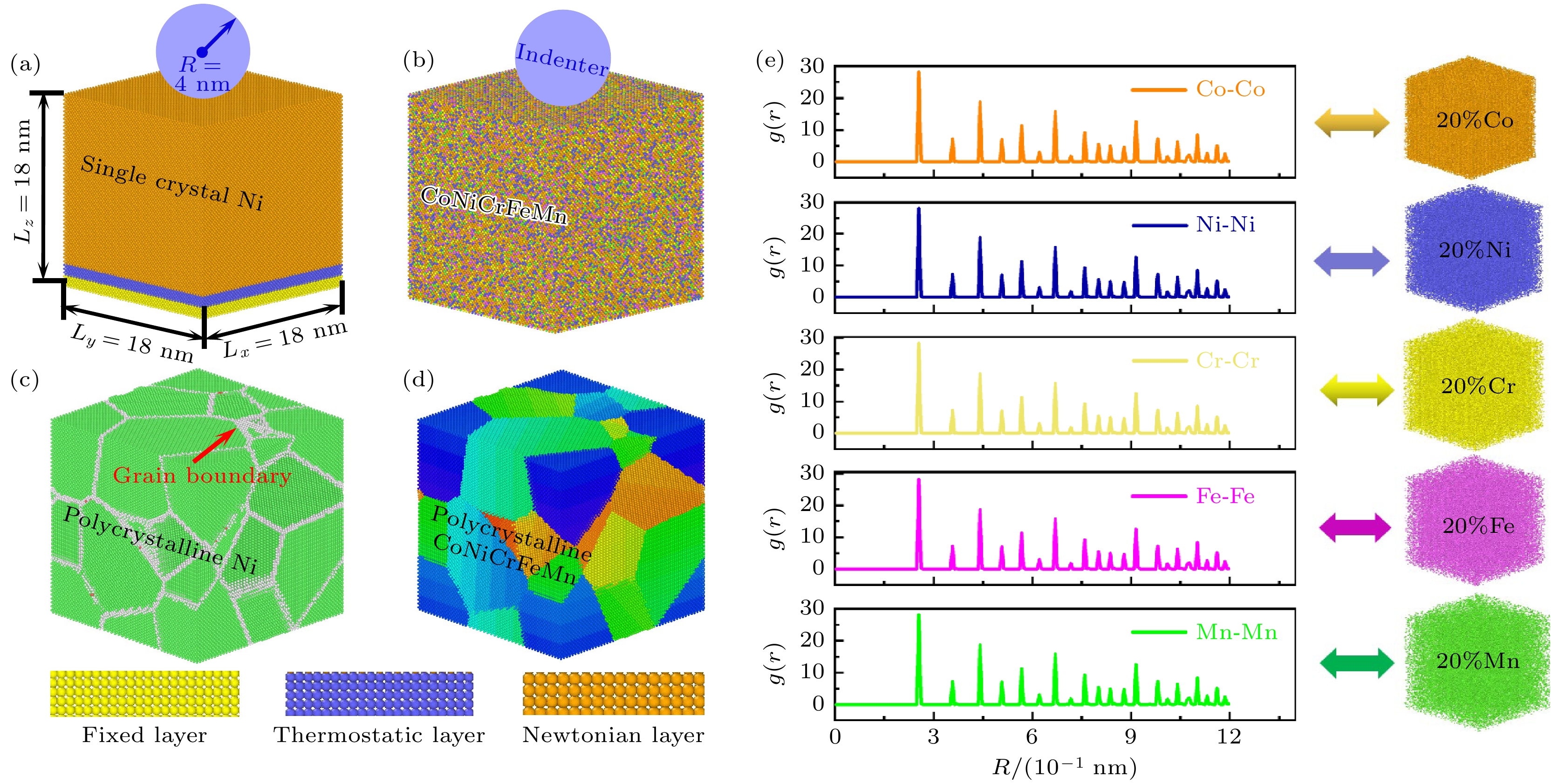
 下载:
下载:
